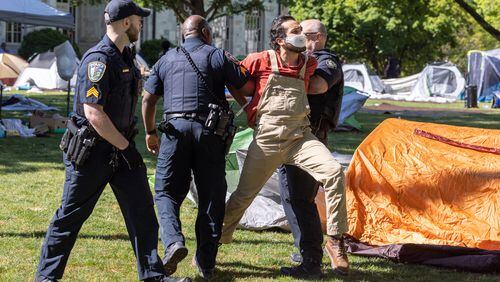With the proliferation of spread offenses in college football, it’s easy to forget about tight ends.
Just 10 were selected among the 256 picks in the NFL draft earlier this year. But Georgia State has three of the hybrid pass-catchers/run-blockers, and they arguably are the strength of the offense as the team prepares to open the season Aug. 27 against Abilene Christian at the Georgia Dome.
It is an interesting situation for coach Trent Miles and offensive coordinator Jeff Jagodzinski because few teams use more than one tight end in anything but goal-line packages. Using as many as three all over the field, as Jagodzinski said will happen, would seem to give Georgia State a schematic advantage because of the uniqueness of the personnel group.
“It creates matchups,” Miles said. “It can open things up for the offense.”
Georgia State will need its tight ends, a group composed of Bill Teknipp, Keith Rucker and Joel Ruiz, because the offense lost its best weapon, wide receiver Albert Wilson, from last season’s team. The offense has depth and potential at running back and wide receiver, but the consistent quality that separates losing teams from winning teams hasn’t been established.
So the tight ends — often called a quarterback’s security blanket — will be crucial to keeping the offense on the field and improving upon last season’s 0-12 record.
“We will use them in the passing game and use them in the running game,” Miles said. “We want to run tight-end sets.”
Many defenses today try to match personnel. It’s easier to do when an offense is playing three or four wide receivers because a nickel package featuring five defensive backs can handle matchup of speed vs. speed.
When Georgia State rolls out two or three tight ends, defenses have to think: If they bring in nickel personnel, the tight ends can stay in to block and give the offense superior numbers and angles to run the ball.
If the defense stays with base personnel in a 4-3 or 3-4 setting, the tight ends can go into motion and finish as wide receivers, which would force linebackers or safeties to try to cover them.
Or the tight ends can be used in some combination that’s not obvious to the defense.
“It causes more time and more investment in that personnel group,” defensive coordinator Jesse Minter said. “It presents a lot of problems.”
Georgia State’s problem-makers throw in the added challenge to defenses of bringing different skills.
“Our uniqueness helps us,” Teknipp said.
A 6-foot-4, 235-pound redshirt freshman, Teknipp said he is a better at blocking than running routes. He played in three games last season before undergoing season-ending knee surgery. He is fully recovered and caught several passes this spring.
Rucker (6-3, 235) took over for Teknipp after his injury and caught 14 passes for 232 yards.
“I’m a receiving tight end, but doing my best to improve my blocking,” Rucker said. “We all can share what we know, and that’s what makes us such a great group.”
Lastly there’s Ruiz, one of the better athletes on the team. Ruiz, who sat out last season after transferring from Presbyterian in the spring of 2013, is the complete package at the position because he has the size (6-4, 240) to block and the speed to go into motion and line up as the slot receiver or move into the backfield as a fullback or even a running back. Ruiz said he is most comfortable split out.
Ruiz, who played quarterback in high school, said he has studied Saints tight end Jimmy Graham and Tony Gonzalez to learn more about his craft.
The combination could help first-year starting quarterback Nick Arbuckle and as many as three new starters on the offensive line settle in before the conference season starts.
“It will be fun to watch,” Jagodzinski said.
About the Author






